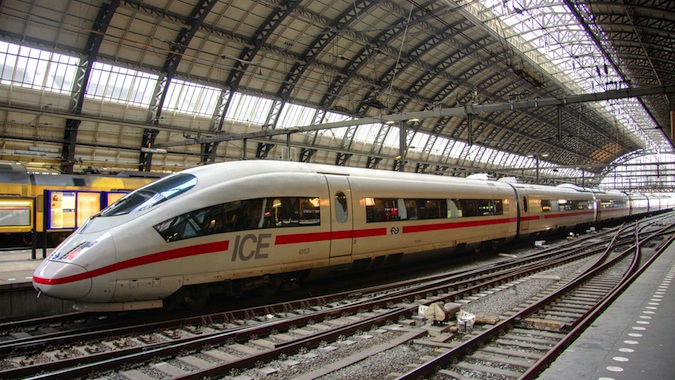Check "Cheap Vacations" on Amazon: http://amzn.to/2uwUxYD
 The One Bag Traveler recommends Gear, Destinations and Adventures.
The One Bag Traveler recommends Gear, Destinations and Adventures.

Updated: 07/01/2018 | July 1st, 2018
Do Eurail passes actually save you money or are they a giant waste of time?
This is the eternal question every traveler to Europe faces. Whether you are going for two weeks or two months, everyone wonders if they will save money by buying a rail pass or if it’s cheaper to buy tickets as they go?
It used to be that you could buy a rail pass, hop on a train, and go wherever you wanted. And if you needed a reservation for the seat, it didn’t matter whether you had a pass or not — if there was a seat on the train, you got it. Now there are often only a set number of seats available for pass holders on any given train, and many countries have instituted high-priced reservation fees (I’m looking at you, France!).
Additionally, as railways have had to deal with the rise of budget airlines, they have changed their pricing model to more closely imitate airlines. Now they now tend to offer cheap early-bird prices and expensive last-minute fares.
Let’s break down the cost of Railpasses and if they are worth the money or not:
Rail Europe vs Eurail vs Interrail: What’s the Difference?
Here’s the difference: Eurail is the name of the consortium that works with all the national rail companies to create the Eurail train pass. RailEurope is an official reseller of the tickets and passes that Eurail creates. Interrail is the same pass but for Europeans only. Eurail/RailEurope is for non-Europeans. While Eurail sells the same pass as RailEurope, RailEurope often sells these passes at a discounted price so it’s usually better to buy it from them. (They actually sell more passes than Eurail.)
The Math: How Much I Spent
It’s all about the money with the passes. If you are going to save money, you want the pass. Here’s a breakdown of what the expenses for my latest trip looked like:
| Train | Ticket Cost With Pass | 1st Class (w/o pass) | 2nd Class (w/o pass) |
| Lisbon – Madrid (overnight single sleeper) | 97 | 151 | 60 |
| Madrid – Paris (overnight single sleeeper) | 192 | 202 | 180 |
| Paris – Brussels | 18 | 124 | 72 |
| Brussels – Amsterdam | 0 | 62 | 34 |
| Amsterdam – Berlin | 0 | 199 | 123 |
| Total Costs | 307 | 738 | 469 |
Note: Prices are in euros and reflect last-minute departure prices that were given to me at the train station at the time of booking.
The pass I used was a first-class 15-day, two-month Global pass that costs $1,189 USD. (Why first-class? Because it’s the only pass you can get when you are over 28. I think this is a stupid rule by the way. If you’re under 28, you can get a 1st or 2nd class pass.) My pass allowed me 15 non-consecutive days of travel in a two-month period (i.e. 15 train trips). That means the value of each journey works out to be $79 USD.
Since I was only in Europe for two weeks, I didn’t use my entire pass. The five train rides I took have a value of $395 (one third the value of the pass).
With all the fees for seat reservations plus the base pass price, the total cost of my train trips were $800 USD. Without the pass, my first-class tickets would have cost me $975 (738 Euros), which means I saved $175 by using the Eurail pass.
Using the Pass
I never had any problems finding a seat, except on the Paris–Amsterdam journey, which required me to book a seat in advance. The Thalys train has a limited number of passholder seats, and since I didn’t pre-book a ticket, instead of traveling direct, I had to make two stops. It made the journey cheaper but also a lot longer than it needed to be. Seat reservations on night trains are required.
On the Eurail iPhone app, you can filter for “Trains without compulsory reservation.” This can help you avoid seat reservation fees. For the most part, Germanic and Central Europe countries allow you to just hop on almost any train. In France, Italy, and Spain, you’ll need a seat reservation. You can book your reservations at the train station. Never do it online or the pass providers directly as it’s more expensive than going directly to the station.
Should You Buy a Eurail Pass?
 So are Eurail passes worth purchasing?
So are Eurail passes worth purchasing?
Maybe.
A lot of people assume train travel in Europe requires a pass, purchase one without looking at the numbers, and then complain about the cost.
Rail passes are all about money. If it doesn’t save you a dollar, it’s not worth getting. That means you have to do a lot of math to figure out if a pass is right or not. It can be a time-consuming process but is certainly worth it in the end.
Just like the airlines, prices are now variable and no longer fixed. Depending on when you book, your ticket cost will fluctuate. If you are willing to pre-book months (tickets usually go on sale 90 days out) in advance, you’ll easily find some unbeatable bargain deals such as Paris to Amsterdam from $46, Rome to Venice from $38, or Amsterdam to Berlin from $78. Denmark offers orange tickets that are 50% off the normal price. Since rail passes cost roughly $79 per trip, you can’t beat booking individual tickets in advance.
But who pre-books a multi-month trip to Europe? Not many.
After you have a general idea as to where you want to go, visit the national railway websites and work out two sets of prices: one for tomorrow (i.e., a last-minute fare) and one for two months from now (i.e., an early-bird fare). Add up the prices in each category.
Next, head to Rail Europe, find your rail pass, and divide the rail pass price by the number of days you’ll be traveling by train to figure out the cost of each journey on the pass.
See which is cheaper and take that option, bearing in mind that your journey may change or you may take more high-speed rails. If I know I’ll be in a lot of countries that don’t charge reservation fees and the prices are for booking early versus using a pass are close, I’ll go with the pass, as there is value in flexibility (I change my mind a lot).
You should buy a Rail Pass if….
- You are traveling around Europe with no fixed plans. To me, the pass is about flexibility and being able to hop on and hop off trains when you want. If you are traveling long-term, you aren’t going to pre-plan months of travel. You are going to want the ability to go with the flow, which using a pass will give you. I place a value on flexibility.
- You will be taking a lot of ferries. Passholders get 50% off ferries in Greece, Italy, and Germany, 40% off ferries in Finland, and some other bus discounts.
You should NOT buy a Rail Pass if….
- You are planning on a short trip and you already know your dates. Those early-bird (non-pass, point-to-point) tickets are non-refundable, they are still cheap and you probably won’t be changing too many of your dates.
- You are traveling to just one country. It’s better to avoid a rail pass as it will cost more than just point to point tickets.
The BEST Solution for Train Travel
The best way to see Europe via train is to use the rail pass for the expensive trains while paying for cheap tickets individually so you can maximize value. For example, for 11 days of train travel in Europe, it’s cheaper to buy a 10-day Eurail Global pass plus one point-to-point ticket for a short distance train.
BOTTOM LINE? If you are traveling vast distances over multiple countries, using a lot of high-speed trains, and traveling (semi) last-minute, a European rail pass is going to save you money.
If you want to book a pass, use Rail Europe. They are the largest broker of European rail passes outside of Europe (and the only option for non-Europeans.) Additionally, RailEurope often has sales that discount their passes or gives you an extra day! (If you live in Europe, you need to go to Interail.com for your pass. Rail agreements prohibit non-Europeans from buying passes outside the continent and vice-versa.)
--------------------------------
